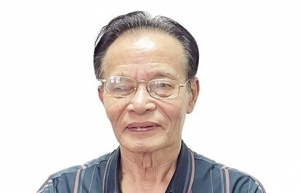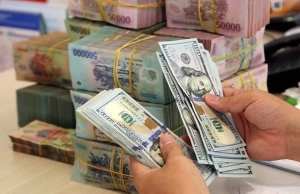A different approach for monetary policy adjustments
The total credit balance of the economy in 2023 reached approximately $566 million, with an estimated $54 million being injected into the market. What has been the response to this?
 |
| Le Hoai An, a banking consultant and trainer at Integrated Financial Solutions |
Money supply growth from 5.5 per cent in 2022 to 13 per cent in 2023 shows a major monetary policy shift. Reasons include economic growth attempts and flexible economic stimulation with managed inflation. The 2023 money supply growth increased in the final three months, with over $33 billion in deposits added in the fourth quarter, equal to the previous nine months. Despite low interest rates, deposits hit a record high in 2023.
In modern economies, deposits can be generated from loans and do not necessarily depend on pre-existing deposits. This means that the push for credit disbursement in the final months of the year is also a key factor in boosting deposits, thereby increasing the money supply.
However, the rapid and synchronised growth in deposits with credit growth in the past month suggests that the disbursed loan capital may not yet be fully utilised in real economic activities. It cannot be ruled out that part of this money supply growth may be channelled into the stock market and gold market.
According to the State Bank of Vietnam (SBV), in 2024, with a credit growth target of 15 per cent, it is estimated that about $83 million will be injected into the economy. Are there concerns over injecting this in terms of inflation?
It’s vital to understand money supply and how it’s pumped into the market in Vietnam as opposed to the United States. In the US, open market operations (OMO) directly inject money into the market, whereas in Vietnam, commercial banks do it.
Thus, Vietnam’s OMO channel regulates money supply rather than injecting it. In 2023, if over $67 million in new deposits increased the money supply, the OMO market injected less than $4.2 billion into the economy. This suggests that commercial banking networks dominate the Vietnamese money supply.
Understanding that a 15 per cent credit growth would equal $8.3 billion with a credit balance of $563 million at the end of 2023 is crucial. This means the former figure will be poured into the economy through bank lending, not directly.
High credit expansion may cause inflation, depending on the economy’s absorption capacity. If money supply injections don’t produce value, inflation may result. The SBV’s 2024 inflation target of 4-4.5 per cent is not accidental, given that inflation was well controlled in 2023 and other countries’ inflation has slowed.
It is said the money supply needs to increase in line with the current price GDP of over 8 per cent, but the actual market dynamics do not align with the theory. Could it be that the method of calculating money supply in Vietnam differs from other countries?
In reality, Vietnam’s money supply by mid-December 2023 was about 9-10 per cent, quite aligned with the standard economic formula when inflation is over 3 per cent and economic growth is over 5 per cent. The sudden increase in money supply towards the end of the year is not yet reflected in the price index, and therefore does not impact inflation in the short term.
Furthermore, with such strong credit growth, Vietnam’s GDP should have seen a more significant rise in the fourth quarter. Therefore, it is likely that the intensified disbursement of credit has not yet entered the real economy, potentially reducing the money circulation velocity in Vietnam in 2023 compared to 2022.
Each country has its own economic structure and financial framework, leading to different approaches and goals in monetary policy. While the US may focus on controlling inflation and macroeconomic stability, Vietnam may prioritise stimulating growth.
Monitoring the correlation between money supply growth and credit growth in Vietnam is also an important signal for investors to assess whether there are phases in which the unabsorbed money supply of the economy might enter the financial markets.
Vietnam’s money velocity was very low in 2022 at 0.64 times a year, and lower the previous years, while in the US it ranges 1.6-2 times/year. What are your expectations for this issue in 2024?
Vietnam’s low money velocity in recent years may be due to cautious spending by individuals and enterprises and financial asset build-up. When the system’s liquidity improved and the money supply increased strongly but wasn’t instantly absorbed in 2023, money velocity may decline.
The fact that Vietnam has much lower money velocity than the US is concerning. The business inventory turnover ratio (cost of goods sold/inventory) measures company inventory circulation. If this ratio diminishes over time, inventory circulation or accumulation may be to blame, reducing inventory turnover.
Consider whether some of the economy’s money supply is being wasted and accumulating in society. If the financial system works better, Vietnam may use less than half of the current money supply to meet its GDP if the US’s velocity is double ours.
 | Variables still at play in global monetary policy Le Xuan Nghia, director of the Business Development Institute and member of the National Financial and Monetary Policy Advisory Council, scrutinises the development prospects in Vietnam and around the world for the remainder of 2023 and beyond. |
 | Monetary policy governance requires thorough consideration: official As the governance of the monetary policy has to concurrently guarantee multiple targets, including reducing interest rates, expanding credit, stabilising foreign exchange rates, and ensuring credit institutions’ safety, thorough consideration is needed before any steps are taken, Deputy Governor of the State Bank of Vietnam (SBV) Dao Minh Tu. |
What the stars mean:
★ Poor ★ ★ Promising ★★★ Good ★★★★ Very good ★★★★★ Exceptional
Related Contents
Latest News
More News
- Stock market starts 2026 with growth and governance in focus (January 06, 2026 | 08:45)
- Cake by VPBank posts strong gains in scale and efficiency leveraging AI focus (January 05, 2026 | 18:55)
- Banks step up listing plans in 2026 to strengthen capital and transparency (December 31, 2025 | 18:59)
- Ho Chi Minh City projects $10.5 billion remittance inflows in 2025 (December 31, 2025 | 18:58)
- New decree sharpens enforcement in securities market (December 31, 2025 | 18:53)
- Gold market reform advances as SBV receives applications for bullion production (December 30, 2025 | 12:07)
- EVN and AFD sign credit agreement for Vietnam’s first pumped storage hydropower plant (December 30, 2025 | 10:06)
- Techcombank Priority Visa Signature unlocks a higher standard of living (December 29, 2025 | 16:44)
- Tax sector wraps up 2025 and sets priorities for next year (December 25, 2025 | 14:00)
- A tipping point for digital and hybrid wealth management in Vietnam (December 23, 2025 | 13:33)

 Tag:
Tag:



















 Mobile Version
Mobile Version